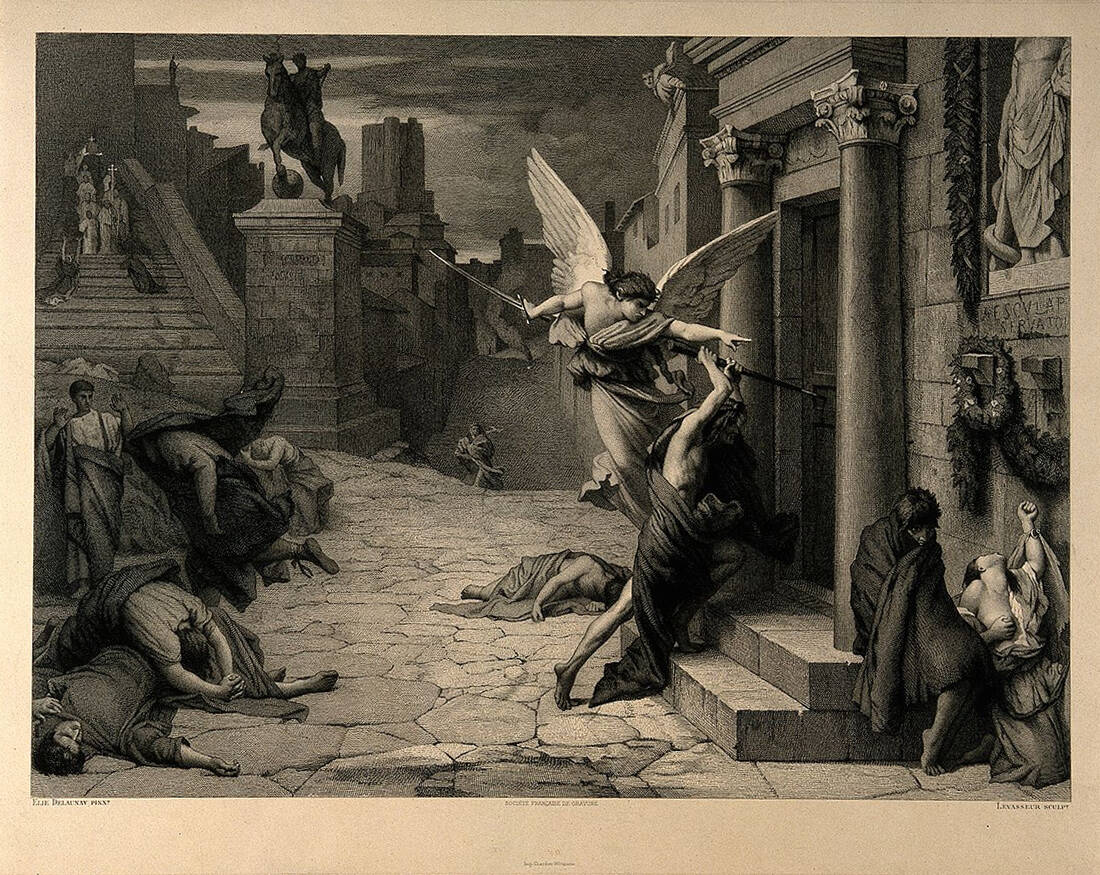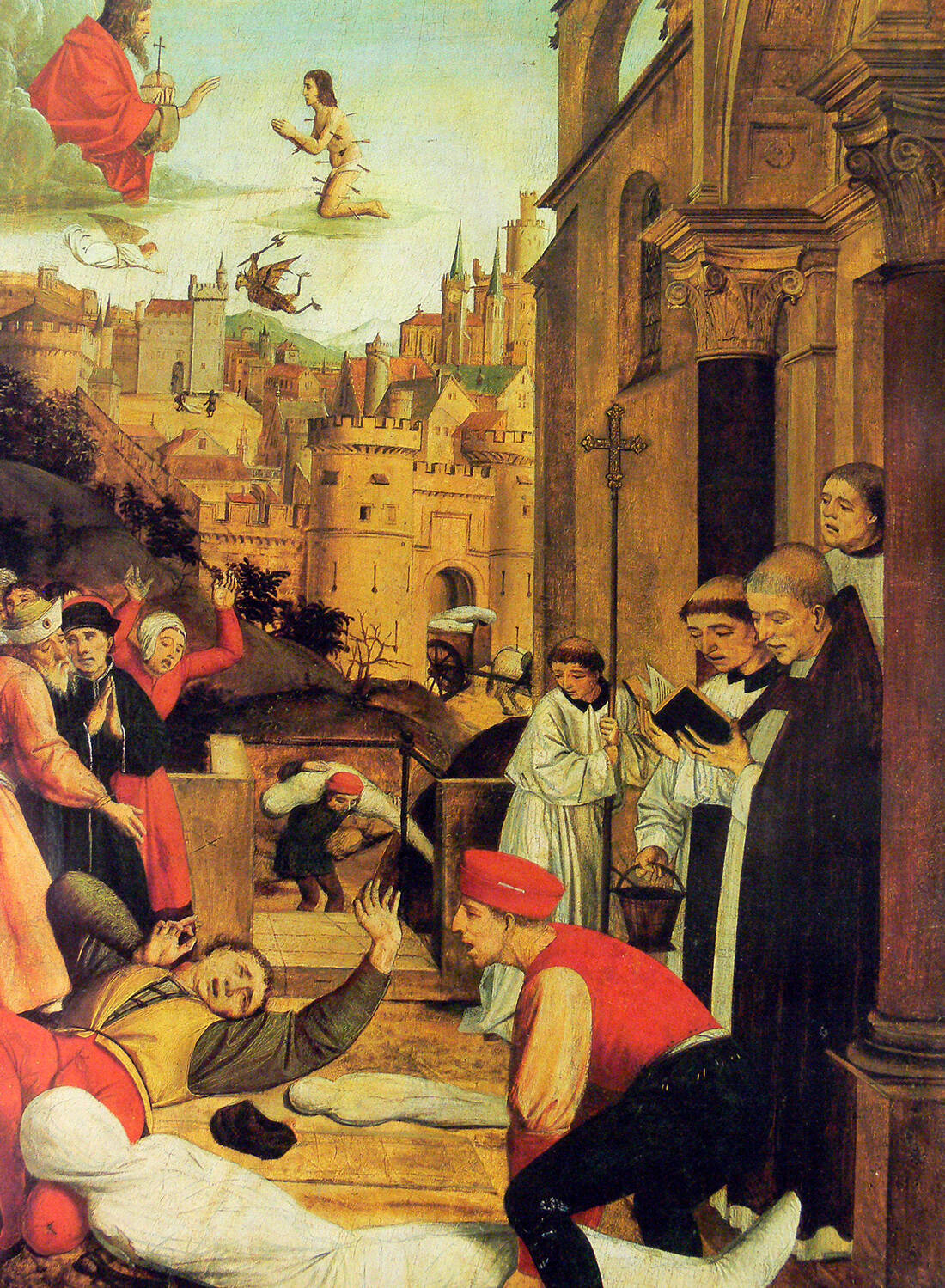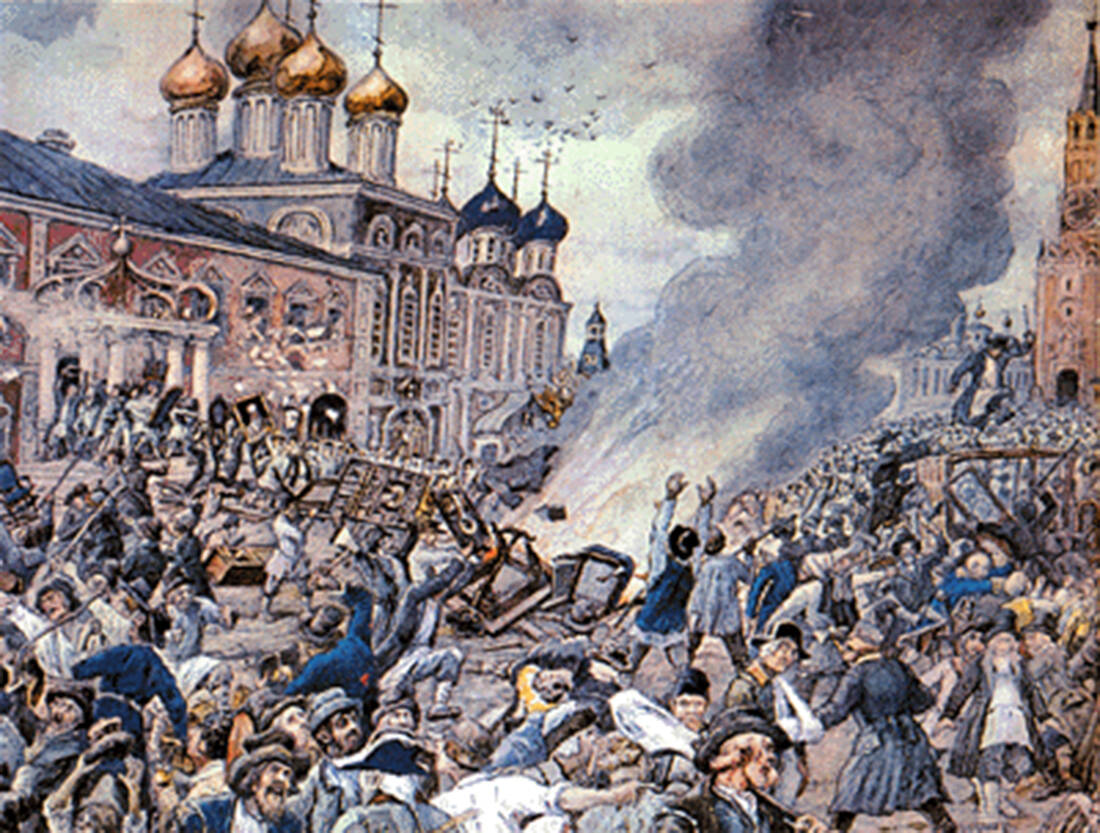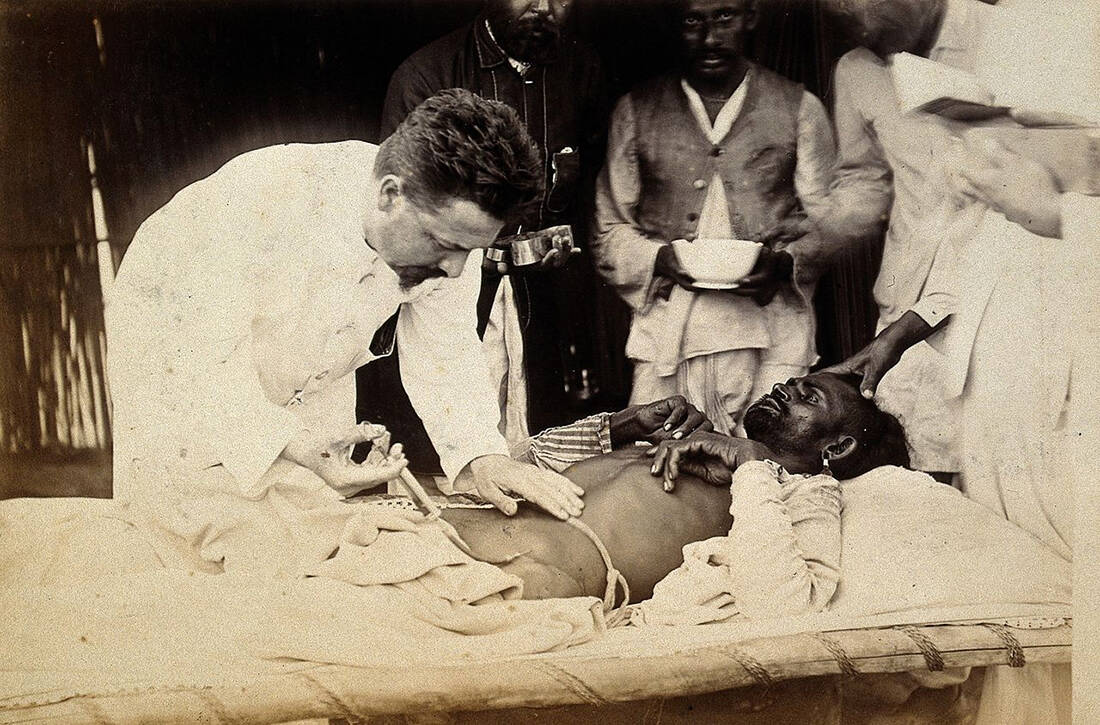And what did not man live in his long history on Earth, experiencing first hand death, panic and doom.
But also situations that mass extinct populations, deserting villages, cities, countries and sometimes even continents.
In the realm of infectious diseases, the pandemic is the worst case scenario. A nightmarish image, for which we unfortunately now have a good appreciation.
Communicable diseases struck man from the very beginning, when he was still a hunter-gatherer.
The real epidemics, however, began 10.000 years ago, when farming began and man formed his first permanent communities.
Malaria, tuberculosis, leprosy, smallpox and flu are things that even our distant ancestors faced.
The oldest epidemic brought to light by the archeological dig comes to us from China, when an entire prehistoric settlement (Hamin Mangha) was erased from the map 5.000 years ago. The bodies of the dead were stacked in a house, which was set on fire.
But the more civilized man became, the farther his trade routes went, the more extensive the epidemics became.
Some even played a leading role, always for the worse, changing even the predetermined outcome of some things.

The oldest recorded pandemic occurred during the second year of the Peloponnesian War. It originated, according to Thucydides, from Ethiopia, spread to Libya and Egypt and reached Piraeus, where it passed through the Long Walls into Athens, which was besieged by the Spartans.
The Plague of Athens struck in three waves (430, 429 and 427-426 BC), wiping out even 1/3 of the city's population (including Pericles) and weakened her so much that she endorsed her downfall.
It is believed to be typhoid fever, although more than 30 pathogens have been suggested as responsible.

Also known as the Plague of Peace, this time it was the Roman legionnaires who returned from the campaign in the Middle East that brought disaster to Rome.
Smallpox or measles historians suspect was an epidemic that may have killed as many as 5 million people in its territory Roman Empire.
Among its victims was the emperor Lefkios Veros, who ruled with his brother, Marco Aurelius Antoninus. According to the historian Cassius Dion, it even caused 2.000 deaths a day in Rome.
The heavy blood tax on the ranks of the army weakened the Roman Empire, at the height of its prosperity, leaving the north to the attacks of the "Barbarians". It was the end of the so-called Roman Peace…

It took its name from the most famous man who told us about it, the early Christian bishop of Carthage, Thaskio Kaikilios Kyprianos. Saint Kyprianos even saw it as a sign for the end of the world.
Historians place its beginning in Ethiopia, from where it spread throughout North Africa, then passing to Rome, back in Egypt and everywhere afterwards in the territories of the Roman Empire.
It is possible that it was the first flu pandemic that humanity experienced. Once again, the pandemic brought Rome to its knees, killing as many as 5.000 people a day.
The widespread shortage of military personnel weakened the empire so much that it provoked the so-called Imperial Crisis, almost half a century of political unrest, civil strife, uprisings and invasions that threatened the existence of Rome.

It appeared in Egypt and found its way to the heart of the Byzantine Empire. And it was probably the first recorded epidemic inguinal plague, the infectious disease caused by the bacterium Gersin's bacillus.
The pandemic struck the entire Mediterranean basin and struck two powerful empires, both the Eastern Roman and the Sassanid empires in Persia. Istanbul was also hit mercilessly, with 5.000 deaths a day. The city was deserted, losing almost half of its population.
Justinian's Plague was the first large-scale catastrophic pandemic, claiming a heavy blood tax.
Some 25 million people lost their lives, thwarting Justinian's ambitious plans to reclaim Rome's lost western lands.
The next waves of the plague in the next two centuries would send the dead to 50 million, 26% of the world's population. Even Justinian was struck by the plague, but survived…

The last reappearance of Justinian's Plague took place in 750 AD. Mankind believed that the plague was over, but six centuries later it was to experience even more horrific situations.
Black Death, often referred to as this medieval outbreak of inguinal plague, has killed as many as 200 million people in Europe, Asia and North Africa. The most modest estimates put the death toll at 75 million, with the most pessimistic at 200 million. Within five years.
The Black Death wiped out 1/3 of the world's population. Its first outbreaks were probably in Asia and the plague moved west with caravans and trade missions.
From the ports of Sicily he dug into Europe and the corpses were so many that they could not be buried. They continued to rot in the cities, drowning the atmosphere in stench.
England and France were decimated to such an extent that they were forced to make a truce. Britain's feudal system collapsed and the plague turned into a vehicle for economic and social change.
It was the first time that the quarantine measure worked. Although they did not know the cause of the infection, they noticed in a difficult way that the proximity had a lot to do with the transmission of the disease.
The Venetians were the first to institute the quarantine of sailors, they had to stay for 30 days (trentino) on the ship before stepping into port. Later the isolation reached 40 days (quarantino), giving us one of the words which concern us a lot today.
With so many dead, labor became rare. And well paid. It was the end of the system with the slaveholders. Those who lived saw their lives change for the better, with more access to meat and better quality bread.
It would take more than 3 centuries for the world population to return to pre-1347 levels.

It is sometimes called the "Exchange of Columbus" and was nothing but the smallpox that the European brought to the New World. Europe and Asia had experienced its destructive action many times (it killed 30% of cases), but on the new continent it was unheard of.
The Old World tax on smallpox would be nothing but what the Native Americans would suffer when the first ships of European explorers arrived on its shores.
The Spaniards brought smallpox, measles and plague to the Caribbean. In the virgin populations of America, infectious diseases became pandemics. Even 90% of the indigenous population is estimated to have been eradicated from the diseases brought by the European colonist.
When Columbus arrived in Hispaniola, he met the local Taino tribe of 60.000. By 1548 there were only 500 people left.
Even the Aztec empire was destroyed in 1520 by a smallpox epidemic. The Aztecs were tragically decimated and weakened to the point where they could no longer fight the conquistadors. Hernan Cortes. The same happened with the Incas in their battle with him Francisco Pizarro the 1532.
The smallpox pandemics, the "red plague," as it was typically called, are responsible for America's heaviest blood tax. It has even been estimated that its impact on the natives of the New World was even greater than the Black Death in Europe.
80-95% of the Native American population disappeared from European epidemics within the first 100-150 years of the arrival of the white colonial. In many parts of what is now the United States and Mexico, the rate has even reached 100%.
Centuries later, smallpox would become the first viral pandemic to end with a vaccine.

It is a fact that London did not breathe from the Black Death onwards. The plague reappeared in the city every decade with great consistency. More than 40 outbreaks are recorded in these 300 years and each disappeared even 20% of the city.
That's probably why the British became the first to think about separating the healthy from the sick. But again they did not escape what it brought them in 1665, when 100.000 Londoners lost their lives in a period of 7 months. 1/5 of the population of the capital.
All public spectacles were banned and cases were forcibly closed in their homes. Red crosses were painted on their doors, next to invocations to God for help. Hundreds of thousands of dogs and cats were slaughtered for fear of spreading it disease.
The largest eruption was to take place in the autumn of 1666 and coincide with the second catastrophic event that struck the British capital: the Great Fire of London, which burned more than 13.000 homes.
A few years later, in 1720 in particular, a similar pandemic would strike Marseilles, France. A ship moored in the port, coming from the Eastern Mediterranean, spreading inguinal plague. It lasted until 1723 and killed 100.000 people, 50.000 in Marseille (30% of its population) and so many others in the suburbs.

In a Moscow that was hit mercilessly by the plague, the terror of quarantine and the means adopted led the people to revolt in an unprecedentedly violent manner. The riots led to the assassination of Archbishop Ambrose, who called on the faithful not to attend services.
The tsarina Catherine the Great, in a desperate attempt to contain the plague and restore order, ordered all factories to leave Moscow. But nothing could stop the catastrophe.
Within two years, the last major plague epidemic in central Russia would claim the lives of 100.000 people in Moscow alone, almost a quarter of its population, killing as many people on its outskirts. The plague came from soldiers returning from the front of the Russo-Turkish War of 1-4.
In September 1771, when he was destroying Moscow, the Muscovites revolted. Within two days the face of the city changed…

It was the first of seven pandemics cholera that would hit the universe for the next 150 years. Its epicenter was Russia, where some 1 million people died.
The cholera epidemic spread and struck British soldiers, who brought it to India, causing several million more deaths.
The famous navy of the British Empire spread it from the Ganges Delta to the lengths and breadths of the universe, from Spain, Italy and Germany to Africa, Indonesia, China, Japan and America, where it killed another 150.000 people.
As Asian cholera also remained in the chronicles, as it affected almost all the countries of the continent. The pandemic stopped in the winter of 1823-1824, with some researchers believing that it was the very severe winter that killed the bacterium.
The first cholera vaccine appeared in 1885, but pandemics continued. The second cholera pandemic struck North America and Europe between 1826-1837, the third broke out between 1846-1860 in North Africa and South America, and the fourth spread from India to Naples and Spain between 1863-1875.
The fifth again focused on India and reached Europe, Asia and Latin America between 1881-1896. The period 1899-1923 was marked by the sixth cholera pandemic, but it was less deadly now. Science now knew the disease well. In Hamburg, Germany, however, 8.600 people died in 1892.
The seventh and final pandemic of the disease would hit Indonesia in 1961, but it was now a mutation in the bacterium. It is what continues to hit developing countries every year…

Historians of science have named the first Plague Pandemic Justinian's Plague and the Second the medieval Black Death. In 1855 was to live the world and the third world outbreak of the disease.
Inguinal plague started in China this time, before moving to India and Hong Kong. It left behind 15 million victims, with 10 of them related to India.
A revolution and a civil war in China caused the plague, at the same time that in India they led to even more repressive measures by the British, causing riots there as well.
According to the World Health Organization, the pandemic was active even until 1960.

The first real flu pandemic recorded began in the steppes of Siberia and Kazakhstan, from where it traveled to Moscow and St. Petersburg and found its way to the Scandinavian and Poland, before moving south and hitting all of Europe.
By next year, the Russian flu would hit the populations of North America and Africa. By the end of 1890, 1 million people would have died. When the world population just reached 1,5 billion.
The last great pandemic of the 19th century, also known in the literature as the Asian Influenza, was the first pandemic that those who thought it was too far to reach them (like the USA) paid even more….

The new flu outbreak has affected 500 million people, 1/3 of the world's population, in 4 consecutive waves, claiming a heavy blood tax of 50 million people. Most estimates put the death toll at 17-50 million, but there are studies that put the numbers closer to 100 million.
Whatever the final number, the Spanish flu was one of the deadliest pandemics of human history. And it was because the man did not take her seriously. Even her name is fake.
It is now known that the first cases were observed in the USA, England, France and Germany as early as December 1917. But it was the years of World War I and such news would throw the morale of the army in the warring countries.
And so they forbade the press to talk about the flu, unless it was about the neutral in the Great War, Spain. Everyone knew about the serious illness that struck King Alfonso XIII, but not about their neighbor.
Thus was born Spanish Flu, during the censorship of the war, only telegrams from Madrid were published in the daily newspapers. Among the victims and many from indigenous communities, who disappeared from the face of the earth.

The world was not over with the flu, everything else. Its new outbreak originated in Hong Kong and spread to China, Singapore and India, before migrating to the United States and from there to England.
England was hit hard, with 14.000 dead in 6 months. The second wave of the Asian Influenza in early 1958 was even more deadly, reaching 1,1 million deaths worldwide. The US met 116.000 of them.
The pandemic was reduced thanks to the development of effective vaccine.

At a time when the world experienced another pandemic in 2003, SARS, which struck 26 countries and 8.096 people, we saved it as humanity with 774 dead. Timely measures and quarantine prevented the disaster.
In the next pandemic we were not equally prepared. Ή lucky. Swine flu was originally named as it appeared in pigs. However, its mutation in 2009 passed to humans.
He was a new executive H1N1, originally from Mexico, which appeared that spring and spread to the rest of the world. Within a year, the new flu hit as many as 1,4 billion people across the length and breadth of the universe.
As for the deaths, not all sources agree, but most put the dead of the pandemic somewhere between 151.700-575.400 people. The largest consensus is the number of 284.000 dead.
According to the US CDC, 80% of the dead were people under the age of 65.

Ο ebola that struck West Africa in 2014 was the most widespread outbreak of the virus in history. It affected Guinea, Liberia and Sierra Leone mainly, acquiring the characteristics of a pandemic.
Again, there is no consensus on the final figures, but most health institutions speak of 28.600 reported cases and 11.300 deaths.
Cases have also been reported in Nigeria, Mali, Senegal, and even isolated cases in Europe (Spain, Italy, England) and the United States, causing waves of terror in the West.
Ebola has no cure, despite ongoing efforts for an effective vaccine. And despite the fact that it first appeared in the Congo in 1976. Even worse, it is a virus with high mortality rates. In its last outbreak it reached 40%.
